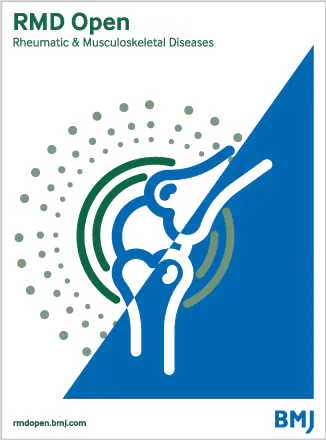小儿 ANCA 相关性肾小球肾炎的病程:倡导年龄包容性方法
IF 5.1
2区 医学
Q1 RHEUMATOLOGY
引用次数: 0
摘要
抗中性粒细胞胞浆抗体(ANCA)相关性血管炎(AAV)是一组以全身中小血管受累并伴有坏死性炎症为特征的疾病,可累及所有器官。尽管其潜在的病理生理学仍未完全清楚,但在肉芽肿性多血管炎(GPA)和显微镜下多血管炎(MPA)中,针对两种主要中性粒细胞蛋白(蛋白酶 3(PR3-ANCA)或髓过氧化物酶(MPO-ANCA))的自身抗体发挥着核心作用。这些自身抗体能够激发和激活中性粒细胞,而中性粒细胞与巨噬细胞、单核细胞和补体系统等其他炎症细胞一起,会导致观察到的内皮损伤。GPA和MPA这两种疾病都有肺部和肾脏受累的倾向,分别有58.6%和82.2%1 的成人AAV患者出现ANCA-肾小球肾炎(GN)。PR3-ANCA 的发病率在纬度较高的国家最高,PR3-ANCA 脉管炎很少发生在日本和中国。2 相当一部分 ANCA-GN 患者的 ANCA 仍为阴性,但有肾脏疾病的表现,其特征是没有或仅有微弱的免疫球蛋白或补体染色。在儿童中,这种疾病极为罕见,这意味着缺乏与流行病学相关的精确估计;不过,据信其潜在的疾病病理生理学与成人的病理生理学十分相似,只是在器官受累的频率上有细微差别。例如,GPA 中的 ANCA-GN 似乎在儿童中比在成人中更常见,而据报道在 MPA 中的发病频率与之相当(图 1)。来自北美(40 个中心)、欧洲(3 个中心)和亚洲(2 个中心)的最大规模队列研究显示,GPA 的发病率几乎是 MPA 的 4 倍。3 2004 年至 2015 年期间,在血管炎患儿登记处(ARChiVE)登记的患儿中,231 名患儿的初始治疗包括皮质类固醇(96.5%)、环磷酰胺(75.8%)、利妥昔单抗(12.1%)和血浆置换...本文章由计算机程序翻译,如有差异,请以英文原文为准。
Course of paediatric ANCA-associated glomerulonephritis: advocating for an age-inclusive approach
Antineutrophil cytoplasmic antibody (ANCA)-associated vasculitis (AAV) is a group of diseases characterised by systemic involvement of small-to-medium vessels with necrotising inflammation that, by virtue, can affect all organs. Even though the underlying pathophysiology is still not fully understood, a central role is devoted to autoantibodies against two major neutrophil proteins, either proteinase 3 (PR3-ANCA) or myeloperoxidase (MPO-ANCA), in granulomatosis with polyangiitis (GPA) and microscopic polyangiitis (MPA). These autoantibodies are able to prime and activate neutrophils that, together with other inflammatory cells such as macrophages, monocytes and the complement system, lead to the observed endothelial injury. Both diseases, GPA and MPA, have a predilection for pulmonary and kidney involvement, with 58.6% and 82.2%1 of adults with AAV presenting with ANCA-glomerulonephritis (GN). The incidence of PR3-ANCA is highest in countries with higher latitudes, and PR3-ANCA vasculitis rarely occurs in Japan and China.2 A significant proportion of patients with ANCA-GN remain negative for ANCA but show signs of kidney disease, which is characterised by the absence or only a faint staining for immunoglobulins or complement. In children, the disease is ultra-rare, meaning precise estimates related to epidemiology are missing; however, the underlying disease pathophysiology is believed to be sufficiently similar to that of adults, with subtle differences reported in the frequency of organ involvement. For example, ANCA-GN in GPA seems to be more common in children than in adults, while a comparable frequency is reported in MPA (figure 1). The largest cohort studies reported from Northern America (40 centres), Europe (three centres) and Asia (two centres) revealed that GPA is almost four times as common as MPA.3 In children enrolled on the A Registry for Children with Vasculitis (ARChiVE) registry from 2004 to 2015, initial treatment among 231 children consisted of corticosteroids (96.5%), cyclophosphamide (75.8%), rituximab (12.1%) and plasma exchange …
求助全文
通过发布文献求助,成功后即可免费获取论文全文。
去求助
来源期刊

RMD Open
RHEUMATOLOGY-
CiteScore
7.30
自引率
6.50%
发文量
205
审稿时长
14 weeks
期刊介绍:
RMD Open publishes high quality peer-reviewed original research covering the full spectrum of musculoskeletal disorders, rheumatism and connective tissue diseases, including osteoporosis, spine and rehabilitation. Clinical and epidemiological research, basic and translational medicine, interesting clinical cases, and smaller studies that add to the literature are all considered.
 求助内容:
求助内容: 应助结果提醒方式:
应助结果提醒方式:


